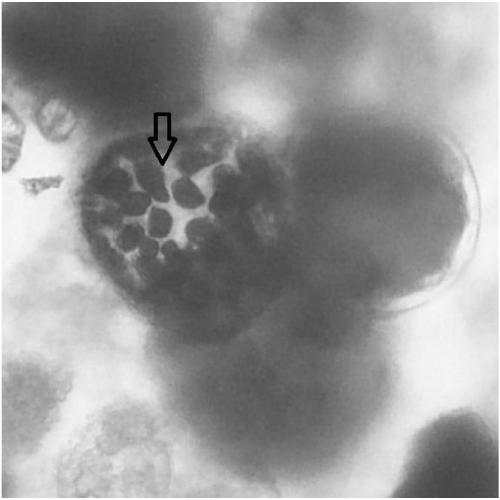Preparation method of ginseng stem cells
A technology of stem cells and ginseng, applied in the field of stem cells, can solve the problems of difficult to control the dosage of auxin, difficult operation, low success rate, etc., and achieve the effects of strong resistance to stress, fast growth, and reduced production costs
- Summary
- Abstract
- Description
- Claims
- Application Information
AI Technical Summary
Problems solved by technology
Method used
Image
Examples
Embodiment 1
[0027] The invention discloses a preparation method of ginseng stem cells, comprising the following steps:
[0028] Step 1. Sampling: Take fresh ginseng rhizomes, sterilize them with a 70% ethanol solution on an ultra-clean workbench for 30 seconds, then sterilize them with a 0.1% mercuric chloride solution for 10 minutes, and then Wash 3 times with sterile water; cut the ginseng rhizome into slices with a thickness of 3 mm; on the rhizome slices, the ginseng cambium presents a circle of dark yellow, such as figure 1 As shown, carefully cut along the dark yellow circle with a scalpel under a stereomicroscope, cut off the dark yellow circle, and cut it into sections with a length of 4 mm and a width of 2 mm;
[0029] Step 2. Preparation of stem cell protoplasts: Soak the above-mentioned sections in the enzymolysis solution containing the following mass fractions: 0.8% cellulase, 0.8% pectinase, 12% mannitol and 86.4% distilled water, and incubate at room temperature After 20 h...
Embodiment 2
[0036]The effect of different enzyme concentrations on the separation of protoplasts was examined, and the results are shown in Table 1. When 0.8% cellulase, 0.8% pectinase and 12% mannitol, the yield of protoplasts reached 9.8×10 3 / g fresh weight, the survival rate reached 95.3%, significantly better than other groups.
[0037] Table 1: Effect of Enzyme Concentration on Protoplast Isolation
[0038] cellulase
[0039] In a word, the present invention not only slices the ginseng root, but also microcuts the cells at the cambium into very thin slices, and then dissociates the stem cells at the cambium and the protoplasts of the surrounding body cells by enzymatic hydrolysis , and then regenerate the cell wall and obtain single-cell clones through nursing culture, and then identify stem cell lines from these single-cell clones. Although this method has many steps, it is easy to implement and has a very high probability of success.
PUM
 Login to View More
Login to View More Abstract
Description
Claims
Application Information
 Login to View More
Login to View More - R&D Engineer
- R&D Manager
- IP Professional
- Industry Leading Data Capabilities
- Powerful AI technology
- Patent DNA Extraction
Browse by: Latest US Patents, China's latest patents, Technical Efficacy Thesaurus, Application Domain, Technology Topic, Popular Technical Reports.
© 2024 PatSnap. All rights reserved.Legal|Privacy policy|Modern Slavery Act Transparency Statement|Sitemap|About US| Contact US: help@patsnap.com










